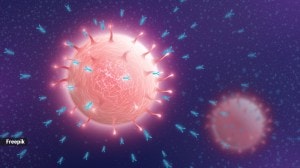Why scientists were surprised to find life under Antarctic ice shelf
The mission was part of Challenger 150, a UNESCO-endorsed global initiative for deep-sea research. The discoveries were announced on Thursday. The findings provide new insights into how ecosystems function beneath floating sections of the Antarctic ice.
 A large sponge on the seabed that was very recently covered by the George VI Ice Shelf. (Photo: ROV SuBastian / Schmidt Ocean Institute)
A large sponge on the seabed that was very recently covered by the George VI Ice Shelf. (Photo: ROV SuBastian / Schmidt Ocean Institute)
A team of scientists may have discovered dozens of new species, including giant sea spiders, octopi, and corals on the newly exposed seafloor left behind by the enormous A-84 iceberg that broke away from the George VI Ice Shelf on January 13.
The break-away of the 510-sq-km iceberg — around two-and-a-half times the size of Kolkata — gave access to an underwater world that was previously beyond human reach. A remotely-operated submersible got to the seafloor on January 25, where it captured photos and videos, and collected specimens.
The mission was part of Challenger 150, a UNESCO-endorsed global initiative for deep-sea research. The discoveries were announced on Thursday. The findings provide new insights into how ecosystems function beneath floating sections of the Antarctic ice.
 A helmet jellyfish
A helmet jellyfish
Life under the ice
Using the remotely operated vehicle (ROV) SuBastian, scientists explored the seafloor for eight days, and found flourishing ecosystems at depths of up to 1,300 metres.
Their observations include large corals and sponges supporting an array of animal life such as icefish, giant sea spiders, and octopi. They also found a giant phantom jelly, a species of jellyfish that can grow up to a metre wide, and a vase-shaped sponge that might be hundreds of years old. Scientists said they may have discovered several new species.
“We didn’t expect to find such a beautiful, thriving ecosystem. Based on the size of the animals, the communities we observed have been there for decades, maybe even hundreds of years,” expedition co-chief scientist Dr Patricia Esquete of the University of Aveiro (Portugal) said in a press statement.
 King crabs
King crabs
A pleasant surprise
The reason scientists were surprised to find diverse ecosystems under the ice shelf is that deep-sea communities typically depend on photosynthesising organisms to rain down nutrients from the surface to the seafloor. “However, these Antarctic ecosystems have been covered by 150-metre-thick ice for centuries, completely cut off from surface nutrients,” according to a report by the British Antarctic Survey (BAS).
 An octopus
An octopus
Scientists have hypothesised that ocean currents, glacial meltwater or something else could be transporting essential nutrients, sustaining life beneath the ice shelf. The precise mechanism fueling these ecosystems is yet to be understood.
At the moment, not much is known about life under Antarctica’s floating ice shelves. It was only in 2021 that BAS researchers first reported signs of bottom-dwelling life beneath the Filchner-Ronne ice shelf in the Southern Weddell Sea.






































